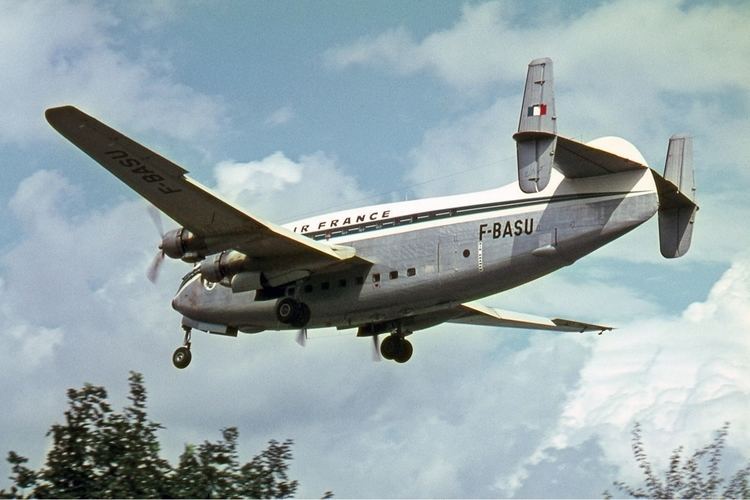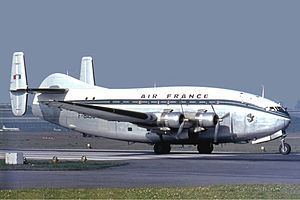Top speed 390 km/h Length 29 m First flight February 15, 1949 | Wingspan 43 m Introduced 10 March 1953 Manufacturer Breguet Aviation | |
 | ||
Similar Breguet 1100, Breguet 730, Breguet 693 | ||
Vol nangis fontenay katana da 20 breguet deux ponts
The Breguet 761/763/765 were a family of 1940s and 1950s French double-deck transport aircraft produced by Breguet Aviation. The aircraft were normally called the Deux-Ponts (Double-Decker) but it was not an official name.
Contents
- Vol nangis fontenay katana da 20 breguet deux ponts
- Design and development
- Civil
- Military
- Accidents and incidents
- Variants
- Operators
- Specifications Br763
- Survivors
- References

Design and development

Breguet began design work on the Breguet 761 double-deck airliner even before the end of the Second World War, in 1944. It was decided that a medium-range airliner with seating for over 100 passengers would be built. The design envisaged using readily available engines with the aim of ease of manufacture and an early first-Flight date. The design was known as Project 76-1. The aircraft was destined not to be the first French postwar design to fly, an honour which instead fell to the Sud-Est Languedoc, a civilianised Bloch MB161. The prototype Br.761, F-WASK, first flew at Villacoublay on 15 February 1949.

The 761 featured a cantilever wing set at mid-height on the bulky fuselage. The retractable tricycle landing gear featured dual-wheel main units. The empennage had twin fins and rudders on a vestigial central fin. The prototype was powered by four 1,580 hp (1180 kW) SNECMA 14R-24 radial engines. The Breguets serving with Air France had up to 107 seats and an elevator between the two floors.

The prototype was followed by three Br.761S pre-production aircraft powered by 2,020 hp (1506 kW) Pratt & Whitney R-2800-B31 radial engines. These were fitted with 12 ft 1½in (3.70 m) diameter Hamilton Standard propellers. The aircraft successfully completed their trials incident-free. Their first flights were in 1951 and 1952.
The French Government ordered 12 production aircraft, the Breguet 76-3, which was later redesignated Br.763. Six aircraft were to be operated by Air France and the other six by the Ministry of Transport. The 763 had more powerful engines, a 1.20 metres (3 ft 11 in) larger wingspan, strengthened wings and a three-crew flight deck (earlier aircraft had four crew). The 763 first flew on 20 July 1951 and entered service with Air France during autumn 1952.
The Air France aircraft had accommodation for 59 passengers on the top deck, and 48 on the lower deck, although the aircraft was capable of carrying 135 passengers in a high-density layout. During 1964 Air France transferred six Br.763s to the French Air Force. The air force also acquired the three pre-production Br.761S aircraft and four new Br.765 Sahara freighter aircraft with removable cargo doors.
Projects to build versions powered with British engines (for possible United Kingdom buyers) did not come to fruition. The projects would have been the 766 (with the Bristol Hercules radial engine), and the 767 with British turboprop engines.
Civil
The prototype Br.761 entered service with Air Algérie in 1952 as a cargo aircraft. It was withdrawn early the next year. Silver City Airways leased a Br.761 for three months in the summer of 1953 for use on the Hamburg - Berlin route. A total of 127 round trips carried 4,000,000 pounds (1,800 t) of freight with up to three round trips being made in a day, each leg taking 52 minutes flight time. It was rumoured that Silver City would purchase three aircraft at £770,000 but this did not materialise into a sale.
The Breguet Br.763 Provence entered service with Air France on 10 March 1953. The inaugural route was Lyon - Algiers. The type was used on European routes from Paris, mainly to the Mediterranean area, but occasionally to London. Domestic routes included Paris to Lyon, Marseille and Nice.
Six aircraft were used in response to a serious incident at Salat, Algeria where French oil rig engineers were in need of assistance. A total of 60 tonnes of heavy equipment and 200 personnel were moved to and from Algiers in four days.
The introduction of the Sud Aviation Caravelle rendered the Provence obsolete as a passenger aircraft. The Caravelle was faster, more comfortable and had a greater range. In 1958, Breguet borrowed F-BASQ from Air France for a sales tour to North and South America. This was the aircraft which had force-landed at Pont-Évêque in 1955. The tour covered 25,000 miles (40,000 km), and took in the cities of New York, Washington, D.C. and Miami in the United States, Bogotá in Colombia, Santiago in Chile, Rio de Janeiro and Brasilia in Brazil. The tour failed to generate any orders. In North America, the jet age had begun, while the aircraft had too great a capacity for operators in South America, despite being cheaper on a cost-per-seat to operate than a Douglas DC-4. The Provence was used on fewer and fewer passenger services, being replaced by the Caravelle and Vickers Viscount. Six aircraft were transferred to the Armée de l'Air. Air France converted the six remaining Br.763s into freighters with the name Universale. These remained in service on European freight services until the early 1970s. The final flight was on 31 March 1971 from Heathrow to Paris-Orly. A double-deck AEC Routemaster bus was parked alongside the aircraft to mark the retirement of the Br.763 from service.
Military
In October 1955 an order for 30 Breguet Br.765 Sahara aircraft for the Armée de l'Air was announced. This order was cancelled by the end of the year, but construction on four aircraft was so far advanced that they were completed. These entered service with 64 Escadre de Transport.
The French Air Force acquired the three pre-production Br.761S aircraft, these and the six Sahara aircraft acquired from Air France provided the French Air Force with a valuable transport fleet for moving personnel and materials to the Pacific nuclear testing areas. The Sahara fleet was retired in 1972.
Accidents and incidents
The Breguet Deux-Ponts had an excellent safety record.
Variants
Operators
Specifications (Br.763)
Data from Jane's All The World's Aircraft 1953–54
General characteristics
Performance
